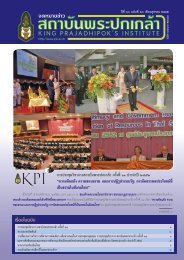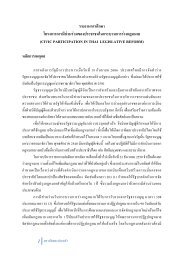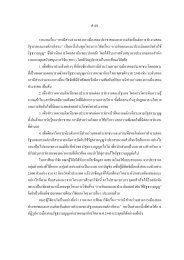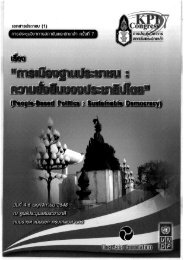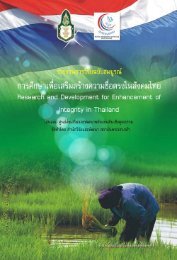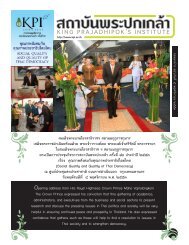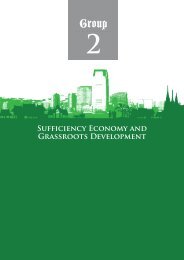Conflict, Legitimacy and Government Reform: Equitable Allocation of ...
Conflict, Legitimacy and Government Reform: Equitable Allocation of ...
Conflict, Legitimacy and Government Reform: Equitable Allocation of ...
You also want an ePaper? Increase the reach of your titles
YUMPU automatically turns print PDFs into web optimized ePapers that Google loves.
Panel Discussion<br />
We’re still waiting for study results. However, there are enough statistics<br />
that can give us a picture that there is a rather high concentration.<br />
During 1995-2004, it was found that 11 families traded positions among<br />
the top-5 families with the highest value <strong>of</strong> shares, including Maleenon,<br />
Shinawatra, Damapong, Jirathiwat, Bencharongkul, Damrongchaitham,<br />
Asavabhokin, Liewphairat, Photharamik, Kannasutra <strong>and</strong> Jaranachit<br />
(Netnapha, 2006: 99-100)<br />
L<strong>and</strong>: L<strong>and</strong> ownership is still the most vital source <strong>of</strong> wealth in the<br />
Thai society. Table 2 illustrates distribution <strong>of</strong> agricultural l<strong>and</strong><br />
ownership by l<strong>and</strong> size in 2006 which reveals a distinct concentration.<br />
The group that doesn’t own any piece <strong>of</strong> l<strong>and</strong> makes up almost 20 per<br />
cent <strong>of</strong> the total. When combining this group with the group owning 10<br />
rai or less, both groups make up 42 per cent <strong>of</strong> the entire country. Some<br />
people might argue that owing 10 rai is a lot. In fact, if you own 10 rai <strong>of</strong><br />
l<strong>and</strong> in the Northeast <strong>and</strong> the l<strong>and</strong> is located in an arid area or has saline<br />
soil. Ten-rai <strong>of</strong> l<strong>and</strong> doesn’t mean anything. This is an important point<br />
because one-third <strong>of</strong> farmers in the country lives in the Northeast <strong>and</strong><br />
faces problems with infertile soil conditions. Thus, 42 per cent <strong>of</strong> farmers<br />
owning 10 rai or less or having no l<strong>and</strong> at all is considered a very high<br />
ratio.<br />
Table 2: Distribution <strong>of</strong> l<strong>and</strong> ownership <strong>of</strong><br />
farmer households in Thail<strong>and</strong> (2006)<br />
L<strong>and</strong> size %<br />
None 18.42<br />
Less than 10 rai 23.94<br />
10-19 rai 24.91<br />
20 rai or over 22.73<br />
Source: Adapted from Duangmanee 2009: 6-6<br />
Another study carried out by an expert in l<strong>and</strong> economics from the<br />
Department <strong>of</strong> L<strong>and</strong> Development concluded that most l<strong>and</strong>s are in the<br />
h<strong>and</strong>s <strong>of</strong> a marginal number <strong>of</strong> people, that is, 10 per cent <strong>of</strong> the<br />
41



